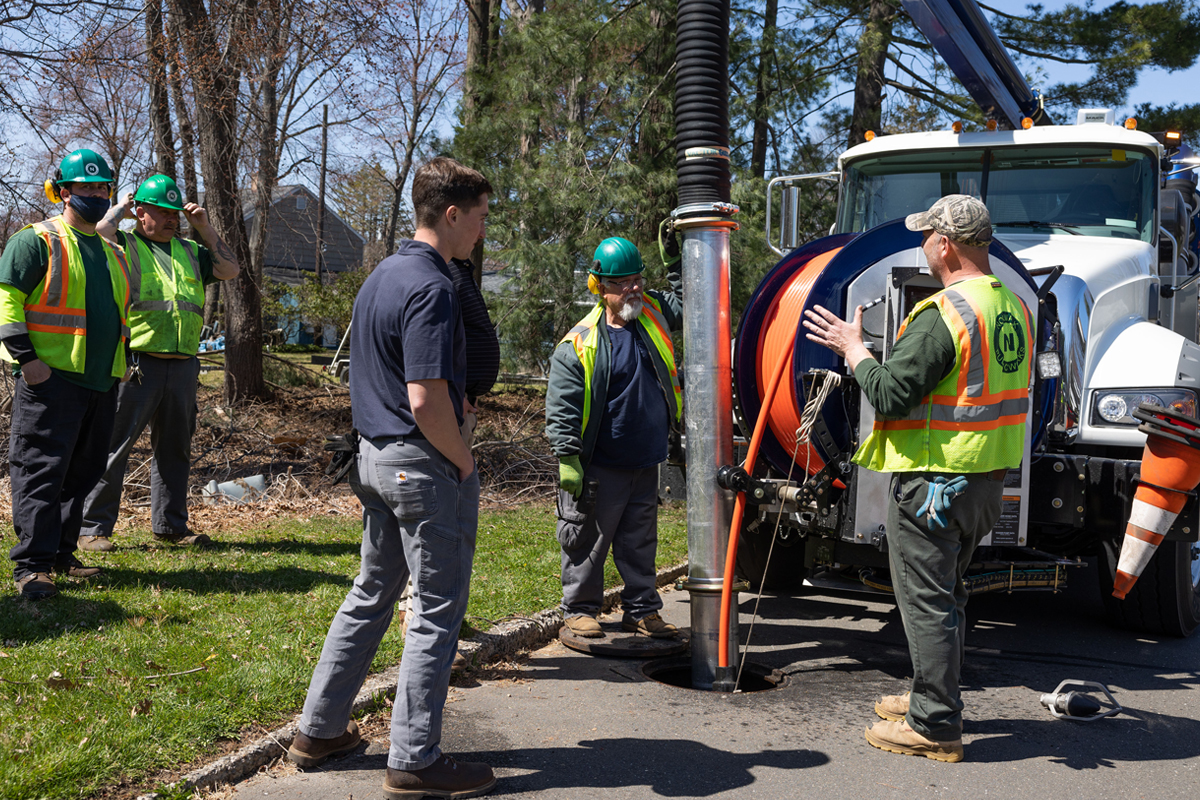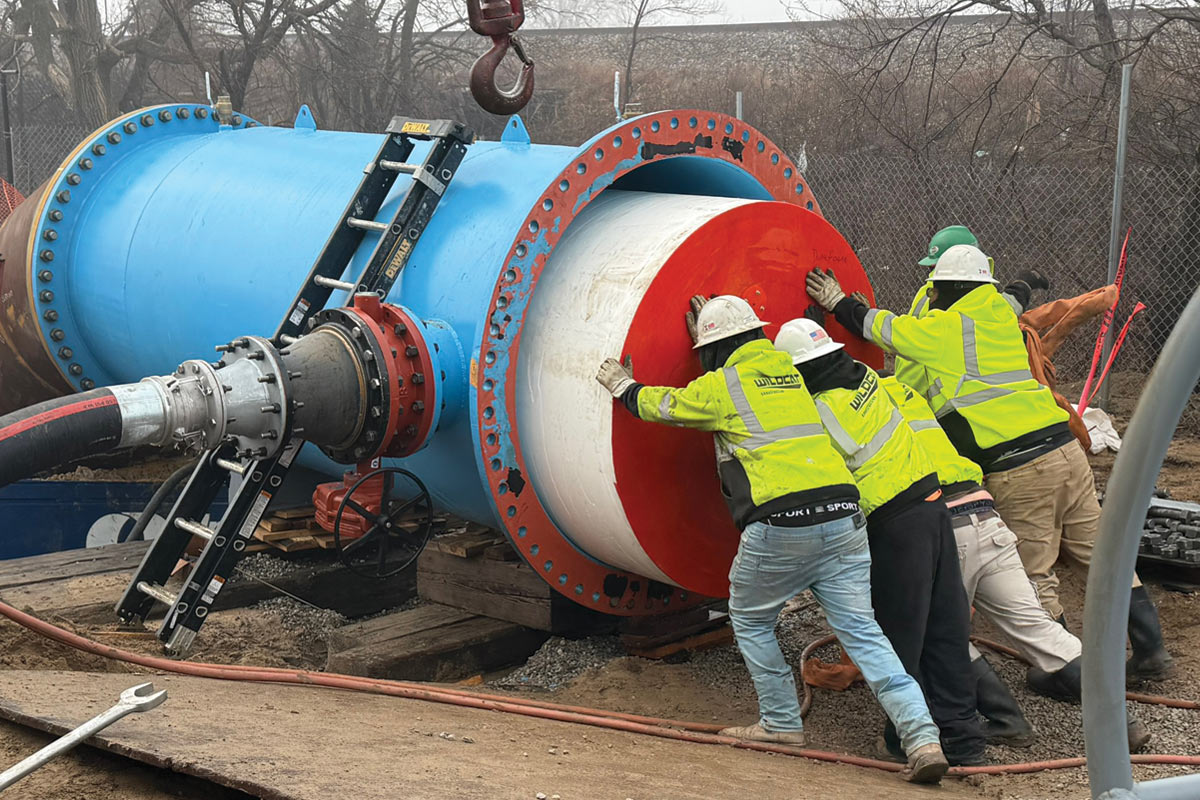Planning of Sewer Rehabilitation in Minden and Roesrath, Germany
April 27, 2011
 Last October, the main sewer in the Westphalian City of Minden, Germany, was comprehensively repaired at a length of 190 m (approximately 650 ft), including leaking joints, shards and originally improperly connected laterals.
Last October, the main sewer in the Westphalian City of Minden, Germany, was comprehensively repaired at a length of 190 m (approximately 650 ft), including leaking joints, shards and originally improperly connected laterals. At a depth between 4.80 and 5.20 m (approximately 14 to 16 ft) with the local soil conditions of heavy clay and gravelly sand, initially there was no detailed information about the existing compaction of the sewer line. Here, the CCTV inspection of the main line and the laterals helped. Soil reports in connection with a geo-physical process by way of geo-radar were to give additional information about voids and bedding problems.
Quick Solution Needed
It turned out that there was no serious compaction problem, “Yet, at the leaking joints and above the lateral connections there was indeed a massive infiltration of groundwater,” explains Ulrich Schmidt of the City Works Minden (SBM).
 In cooperation with the engineering firm IWA of Minden, the option of a constructing a new pipe in an open trench was quickly dismissed – as it was too costly and complex. A new construction would have meant the need for groundwater management. A costly undertaking. “It was for this reason and because there were no major hydraulic load problems, we decided for a repair from the inside,” says Schmidt. “With this option, we used a Close-Fit-Liner, which meets the onsite structural requirements and can be installed under the given circumstances. At the same time, we trusted the Janssen Lateral Rehabilitation Process. No other lateral repair system can connect and seal these laterals so well.”
In cooperation with the engineering firm IWA of Minden, the option of a constructing a new pipe in an open trench was quickly dismissed – as it was too costly and complex. A new construction would have meant the need for groundwater management. A costly undertaking. “It was for this reason and because there were no major hydraulic load problems, we decided for a repair from the inside,” says Schmidt. “With this option, we used a Close-Fit-Liner, which meets the onsite structural requirements and can be installed under the given circumstances. At the same time, we trusted the Janssen Lateral Rehabilitation Process. No other lateral repair system can connect and seal these laterals so well.” This solution is based upon a special packer and a special two-component resin: After a series of protruding laterals and other obstructions were removed using a cutting robot, the actual rehabilitation could begin. The packer was placed at the damage spots and inflated by compressed air. Then the liquid 2-component resin was injected through the damaged areas. “The resin fills the voids, displaces the groundwater and bonds with the bedding material – this way the actual sealing and stabilizing happens on the outside of the pipe,” said the managing director of the Goch-based service company Janssen Umwelttechnik GmbH. “Even the annulus between the Close-Fit-Liner and the host pipe is filled and sealed up to 1 m to the left and right of the lateral.”
This solution is based upon a special packer and a special two-component resin: After a series of protruding laterals and other obstructions were removed using a cutting robot, the actual rehabilitation could begin. The packer was placed at the damage spots and inflated by compressed air. Then the liquid 2-component resin was injected through the damaged areas. “The resin fills the voids, displaces the groundwater and bonds with the bedding material – this way the actual sealing and stabilizing happens on the outside of the pipe,” said the managing director of the Goch-based service company Janssen Umwelttechnik GmbH. “Even the annulus between the Close-Fit-Liner and the host pipe is filled and sealed up to 1 m to the left and right of the lateral.” The freshly sealed laterals could then be connected to the HD-PE Liner, the so-called Close-Fit-Liner – now there will be nothing standing in the way of unproblematic sewer discharge in Minden-Letelen. “Because the sewer lines and the laterals are now tight, there will be no more sand washed into the pipe through the damaged areas,” observes Schmidt. The total wastewater volume was reduced from 900 cu m to around 300 cu m with this constructive measure. The reduction by two thirds has positive effects on the life of the pumps and leads to more economical operation of the pumping station. “Thus a cost reduction at the umping station comes hand in hand with the rehabilitation of the sewer system,” says Schmidt.
The freshly sealed laterals could then be connected to the HD-PE Liner, the so-called Close-Fit-Liner – now there will be nothing standing in the way of unproblematic sewer discharge in Minden-Letelen. “Because the sewer lines and the laterals are now tight, there will be no more sand washed into the pipe through the damaged areas,” observes Schmidt. The total wastewater volume was reduced from 900 cu m to around 300 cu m with this constructive measure. The reduction by two thirds has positive effects on the life of the pumps and leads to more economical operation of the pumping station. “Thus a cost reduction at the umping station comes hand in hand with the rehabilitation of the sewer system,” says Schmidt. Special Resin Against Groundwater Ingress
 These were reasons for the City Works of Refrath as well to trust the Janssen Process for a rehabilitation
These were reasons for the City Works of Refrath as well to trust the Janssen Process for a rehabilitation measure in an industrial zone: In 2009, the sewer had been inspected by CCTV according to the existing ordinance (SuewVKan). Five damages with significant groundwater ingress were found making an immediate repair inevitable. The service company from the Lower Rhine Janssen Umwelttechnik GmbH applied its lateral repair process here as well. “This way all damages could be sealed and repaired,” says Norbert Fischer of Grid Service Waste Water of the City Works Roesrath.
 The data of the running times at the pumping station prove the successful repair of the sewer pipe. While the pumping station was operating for eight to nine hours prior to the repair, it needed to run only three to four hours later. And the wastewater volume actually pumped shows a significant difference: It was reduced from about 200 cu m to 90 cu m per day. “That – over the year – of course means considerable savings for us,” confirms Fischer. “And in addition we thus prevent the wash-out of the soil because of leaking lateral connections or cracks and the formation of voids.”
The data of the running times at the pumping station prove the successful repair of the sewer pipe. While the pumping station was operating for eight to nine hours prior to the repair, it needed to run only three to four hours later. And the wastewater volume actually pumped shows a significant difference: It was reduced from about 200 cu m to 90 cu m per day. “That – over the year – of course means considerable savings for us,” confirms Fischer. “And in addition we thus prevent the wash-out of the soil because of leaking lateral connections or cracks and the formation of voids.”  By reducing the external water inflow into the waste water stream the City Works not only profit in the short term from the reduction of cost and the well functioning wastewater system but also long term from a safe wastewater management without the danger of streets subsiding according to Rainer Witte, head of the department ofWater/Wastewater grid in Roesrath: “Without this technology all this combined would not have been possible in such a short time. Therefore in future we will always rely on the Janssen Lateral Connection Rehabilitation Processer whenever necessary.”
By reducing the external water inflow into the waste water stream the City Works not only profit in the short term from the reduction of cost and the well functioning wastewater system but also long term from a safe wastewater management without the danger of streets subsiding according to Rainer Witte, head of the department ofWater/Wastewater grid in Roesrath: “Without this technology all this combined would not have been possible in such a short time. Therefore in future we will always rely on the Janssen Lateral Connection Rehabilitation Processer whenever necessary.”This article was submitted by Janssen Umwelttechnik.




